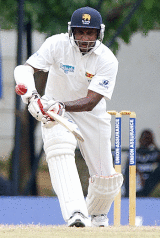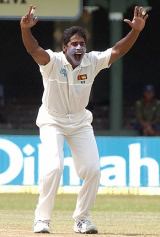Sri Lanka facing unknown territory
With the bold axing of Sanath Jayasuriya, Sri Lankan cricket finds itself in uncharted territory. Charlie Austin investigates
Charlie Austin
11-Nov-2005
|
|

|
The announcement of Sri Lanka's one-day squad to tour India passed with barely a whisper last month. The squad was settled and there were no surprises. But the unveiling of the Test squad for the first tour of India since 1997 is sure to create a storm of debate - and may have serious long-term implications for the future.
The four-man selection panel, answerable to the Sports Minister and headed by Lalith Kaluperuma, have dared go where no panel has gone for a decade - they've axed Sanath Jayasuriya, one of the first choices on a Sri Lanka team sheet ever since a blistering hundred against Australia at Adelaide back in 1995/96.
The decision, justified by the selection panel on the basis of poor form coupled with his slow recovery from a dislocated shoulder, is an extremely bold move that poses the obvious question: is this the beginning of the end for one of Sri Lanka's most influential and exciting batsman in history?
Ironically, Jayasuriya is undoubtedly the batsman that India fears most. He has won countless matches against them over the years and his scalp, even despite his wretched form in this series (85 runs in 6 matches), is the one they celebrate most keenly, knowing full well his dangerous potential and his talismanic influence upon the Sri Lanka batting.
With hindsight, Jayasuriya should not have played at the start of the one-day series, after a banana-boat accident on a team jolly just before the tour aggravated the shoulder he dislocated during the Indian Oil Cup in August. His tentative fielding - including one embarrassing self-preserving pullout from one particular catch - showed he had not recovered sufficiently to play international cricket.
But to drop him now, just when he has started to regain his fitness and even begun bowling again, with three weeks to go before the first Test in Chennai, is a major call. At 36 years old he is no spring chicken, but during the last two years his performances in Test cricket have surpassed his career average (during his last 10 ODIs he has averaged 44.94 compared to a career average of 42.17) and during Sri Lanka's subcontinent tour, to Pakistan in 2004, he was their most prolific batsman.
If the selectors have dropped him on the basis of fitness, in consultation with the team's medical team, fair enough. But if he's been sacked because of a run of low scores in one-day cricket then it makes little sense. Touring India is one of cricket's hardest challenges and a team that travels without one of its best and most destructive players is taking a huge gamble. Put it this way - India must be over the moon.
Jayasuriya must now ponder his future. He clearly wants to bow out at the 2007 World Cup and this, despite his relatively old age, is an achievable objective. But in one-day cricket he must reconsider his indifference to dropping down the order. His vast experience and allround ability could make him an invaluable cog in the middle order in the West Indies where the pitches can be expected to suit Sri Lanka's style of play. However, an insistence on opening may hasten the end of his career.
|
|

|
Moving on, the selectors' decision to fast-track Chamara Kapugedera, a teenage middle-order batsman with immense potential, is praiseworthy. The dearth of upcoming batting talent in Sri Lanka is so worrying that the selectors were right to hand an opportunity to someone who has had development coaches drooling with excitement for several months now. The inexperience, even if he doesn't play, should prove invaluable.
The decision too to promote Malinga Bandara ahead of Upul Chanadana is also justifiable. Bandara, ironically Chandana's overseas replacement at Gloucestershire, has excelled during the past year with the A team and in County Cricket and he deserves a chance to restart a Test career that began and ended way back with a solitary Test against New Zealand in 1998.
Sajeewa Weerakoon's leapfrogging Rangana Herath as the No. 1 left-arm spinner in the island is recognition of his prolific wicket-taking in first-class cricket and with the A team. Whether he has the variation and the nous to trouble India's fleet-footed batsmen - especially on flat pitches - is, however, a concern.
But the selectors had one more surprise in store for the Test series: the axing of Mahela Jayawardene as the vice-captain. Of all the decisions made, this is the one that may ultimately prove the most significant. Unfortunately, it smells so strongly of politicisation that several very senior players are severely concerned.
In Jayawardene's last eight matches against India, he has played match-winning innings in three of them - not bad by anyone's standards. Moreover, in Atapattu's occasional absence, he has led the team astutely, displaying a clear ability to communicate well with the players and shrewdly read the game. So why has he been cast aside?
Chaminda Vaas has been a loyal servant for Sri Lanka cricket for many years. His supreme skill is now acknowledged throughout the world. But there are question marks over his captaincy pedigree on the field. Vice-captains can no longer just drum up morale within the dressing room. With the international calendar so heavily congested, they inevitably have to captain the side on occasion and Vaas's tactical acumen as a leader, based on his recent experience as Western Province skipper, appears limited.
|
|

|
It is no secret that Vaas has long pursued the vice-captaincy with behind-the-scenes lobbying, both personally and from his supporters, who argue that his fine contributions as a bowler merit the recognition of leadership status. For some time the considerable political pressure exerted has been resisted by the selectors. But suddenly, this has changed and it is unclear why. There are, though, two theories.
The first is that Vaas's politicking has finally struck a chord with Jayantha Dharmadasa, the interim chairman of Sri Lanka Cricket, a man that people hoped would bring meritocracy and professionalism to the cricket administration, but who has instead showed an increasingly worrisome penchant for employing his own supporters in key positions.
The second theory is that the selectors, frustrated by the team management's unwillingness to tow the line with regard to the selection of the final playing XI on tour - specifically in this tour the refusal to drop Jayasuriya - wanted a man in the team management (which includes the captain, vice-captain, coach and manager) they could control.
It is unclear which theory holds the most weight at this stage - or whether either theory holds a semblance of truth for that matter - but it is clear that the decision could impact upon the internal dynamics of the team. The selectors' job is not to make the players happy, it is true, but all their decisions must at least have a sound, rationale basis. In this case such reasoning is hard to fathom. Is Vaas being groomed as the next captain, or is he being rewarded for yeoman's service? If it is the latter than Murali, a player that has never pursued official title and concentrated instead on taking wickets, should be the vice-captain.
Sri Lanka have been thoroughly outplayed in this series. This cannot be denied. They also have issues to solve with the make-up of the team, especially the batting order, but it should also be acknowledged that playing India at home - especially an India team enlivened and rejuvenated by the end of Sourav Ganguly's tenure and the return of Sachin Tendulkar - is incredibly difficult.
Sri Lanka are a small cricketing nation with serious structural issues. School cricket appears to be in terminal decline and first-class cricket, bloated to 20 teams this year in a post-tsunami compromise, is a joke. For such a small island national the density of talent is amazing. But the resources are not so rich that mismanagement can be afforded.
The squad chosen for the Test series is a massive gamble. Only time will tell whether they have chosen wisely. But the omens are not good. A squad that was settled and united before this tour, so crucial for all teams but especially those in Asia where politics plays such a depressing part, is now internally fragile. The No. 2 one-day side in the world just two weeks ago is now staring into unknown territory.
Charlie Austin is Cricinfo's Sri Lankan correspondent